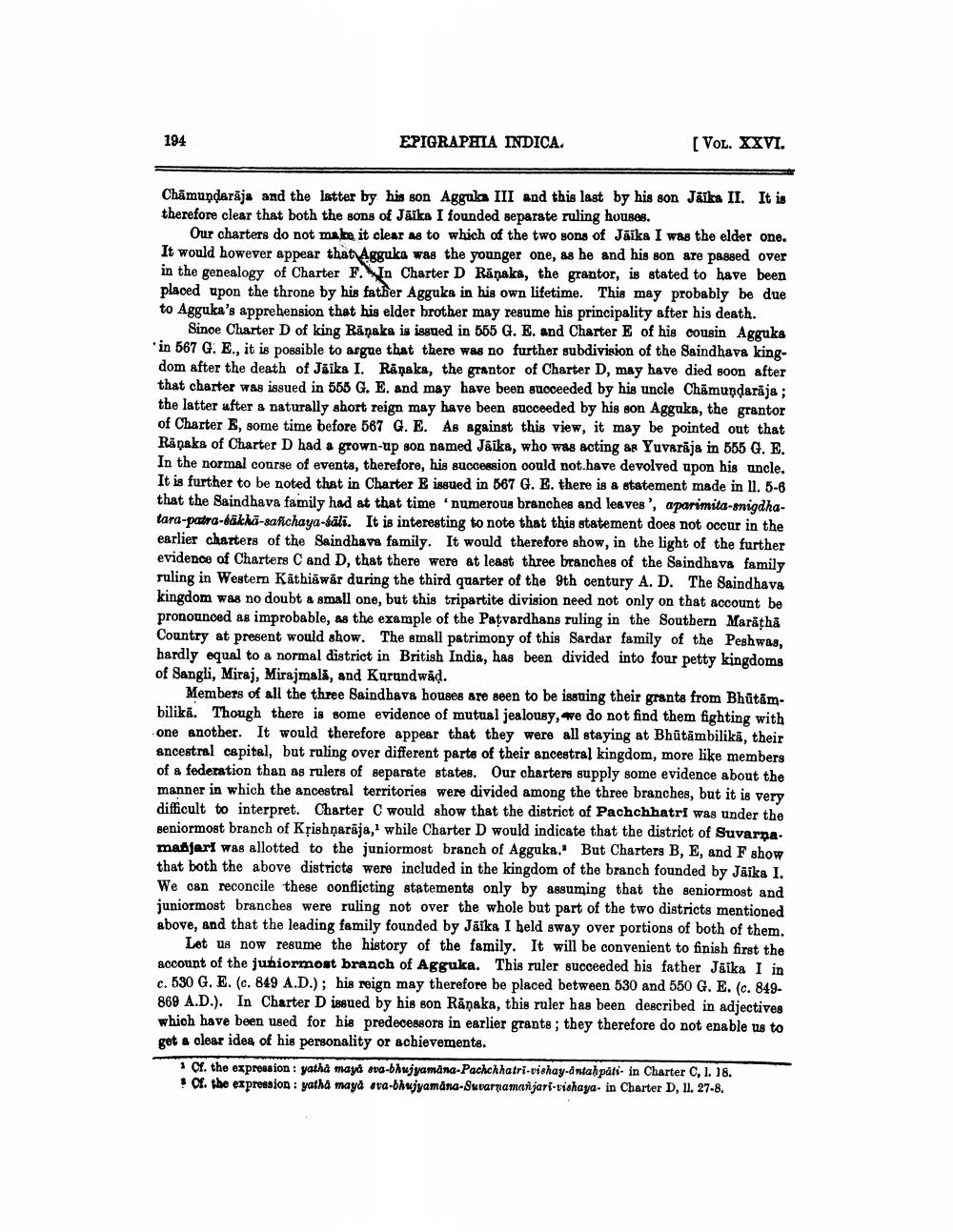________________
194
EPIGRAPHIA INDICA.
[VOL. XXVI.
Chamundarāja and the latter by his son Agguka III and this last by his son Jäika II. It is therefore clear that both the sons of Jāika I founded separate ruling houses.
Our charters do not make it clear as to which of the two sons of Jäika I was the elder one. It would however appear that Agguka was the younger one, as he and his son are passed over in the genealogy of Charter F. In Charter D Rāņaka, the grantor, is stated to have been placed upon the throne by his father Agguka in his own lifetime. This may probably be due to Agguka's apprehension that his elder brother may resume his principality after his death.
Sinoe Charter D of king Ränaka is issued in 555 G. E. and Charter E of his cousin Agguka ' in 667 G. E., it is possible to argue that there was no further subdivision of the Saindhava kingdom after the death of Jaika I. Räņaka, the grantor of Charter D, may have died soon after that charter was issued in 555 G. E. and may have been succeeded by his uncle Chamundarāja ; the latter after a naturally short reign may have been succeeded by his son Agguka, the grantor of Charter E, some time before 567 G. E. As against this view, it may be pointed out that Ránaks of Charter D had a grown-up son named Jāika, who was acting as Yuvarāja in 555 G. E. In the normal course of events, therefore, his succession could not have devolved upon his uncle. It is further to be noted that in Charter E issued in 667 G. E. there is a statement made in II. 5-6 that the Saindhava family had at that time numerous branches and leaves', aparimita-snigdhatara-para-bakha-sanchaya-sali. It is interesting to note that this statement does not occur in the earlier charters of the Saindhava family. It would therefore show, in the light of the further evidence of Charters C and D, that there were at least three branches of the Saindhave family ruling in Western Käthiāwar during the third quarter of the 9th century A. D. The Saindhava kingdom was no doubt a small one, but this tripartite division need not only on that account be pronounced as improbable, as the example of the Patvardhans ruling in the Southern Marathi Country at present would show. The small patrimony of this Sardar family of the Peshwas. hardly equal to a normal district in British India, has been divided into four petty kingdoms of Sangli, Miraj, Mirajmalā, and Kurandwäd.
Members of all the three Saindhava houses are seen to be issuing their grants from Bhūtāmbilikā. Though there is some evidence of mutual jealousy, we do not find them fighting with one another. It would therefore appear that they were all staying at Bhūtāmbilikā, their ancestral capital, but ruling over different parts of their ancestral kingdom, more like members of a federation than as rulers of separate states. Our charters supply some evidence about the manner in which the ancestral territories were divided among the three branches, but it is very difficult to interpret. Charter C would show that the district of Pachchhatri was under the seniormost branch of Kșishộarāja,' while Charter D would indicate that the district of Suvarna. mafjarl was allotted to the juniormost branch of Agguka.' But Charters B, E, and F show that both the above districts were included in the kingdom of the branch founded by Jāika I. We can reconcile these oonflicting statements only by assuming that the seniormost and juniormost branches were ruling not over the whole but part of the two districts mentioned above, and that the leading family founded by Jāika I held sway over portions of both of them.
Let us now resume the history of the family. It will be convenient to finish first the account of the juniormost branch of Agguka. This ruler succeeded his father Jaika I in c. 530 G. E. (c. 849 A.D.); his reign may therefore be placed between 530 and 550 G. E. (c. 849869 A.D.). In Charter D issued by his son Rāņaka, this ruler has been described in adjectives which have been used for his predecessors in earlier grante; they therefore do not enable us to get a clear idea of his personality or achievements.
Cf. the expression : yatha maya sta-bhujyamana-Pachchhatri-vishay-antahpåti- in Charter C, 1. 18. ! Cf. the expression: yatha mayd ora-bhujyamana-Subarnamarijari-vishaya- in Charter D, 11. 27-8.




